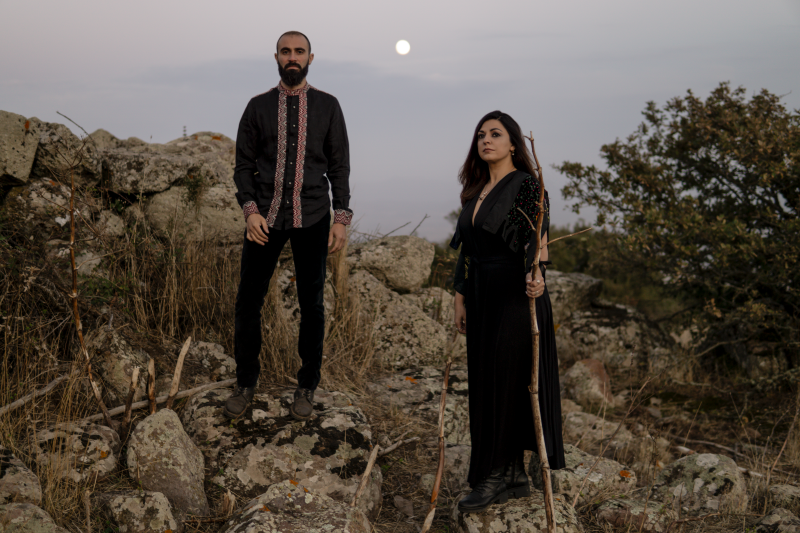With “Jae”, their powerful second album, Ilienses dive even deeper into the soul of Sardinia, weaving together music, memory, and identity. Drawing inspiration from ancient myth, archaeology, and the rich culture of Sardinia, the band offers a unique sonic journey that transcends borders. In this interview, we speak with frontwoman Natascia about the stories behind the music, the deep symbolism of their imagery, and the timeless power of Sardinian tradition.
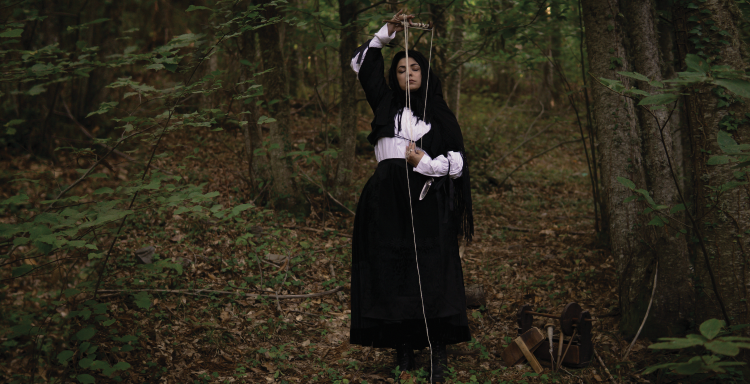
Fully committed to Ilienses
So, Natascia, welcome. First of all, thank you so much for the interview. How are you doing? What are you up to these days here?
At this point in the project, we’re currently concentrating on creating merchandise. Our new record, “Jae“, was released on October 31, 2024, so we’re just a few months out from the launch. We’re in that post-release phase of promotion—doing lots of interviews, receiving reviews, and generally developing all those aspects of outreach.
We’re not in a compositional phase at the moment; instead, we’re focusing on organization. That includes managing all the commitments that have come up following the release of the new album, as well as planning the live shows, which of course feature the new tracks. So yes, we’re deeply engaged in this stage right now—fully committed.
The creation of Ilienses
Now, let me take you back to the early days… Can you tell me—how did Ilienses come into being? What was the origin story? What sparked it all?
Ilienses came to life around 2018. Both Mauro and I came from different musical paths and had different musical interests than what we eventually went on to create with this project. And that’s part of what makes it what it is—something quite varied and layered.
My background included listening to metal—especially the more extreme subgenres. Mauro also came from a metal-listening background, but through his studies, especially at the conservatory, he ventured into jazz and progressive music.
The first album reflected this wide spectrum of influences. I grew up listening to a lot of grunge and punk when I was younger. Genre-wise, I’d say we explored just about everything—metal, jazz, prog, even the rawest blues and traditional spirituals.
So our musical background is very diverse. But with Ilienses, we felt the need to focus on sounds that resonated more deeply with who we were at that moment. That led us toward a sound more rooted in metal, neo-folk, dark folk, and pagan folk.
Interestingly, we didn’t fully realize that at the beginning. Ilienses was born from a deeper desire—to tell the story of our homeland, Sardinia. We began to study its most ancient, primitive sounds, those rooted in its folk traditions. Folk music was always in our ears growing up; it’s part of our cultural DNA. Over time, those sounds blended with our modern influences, and what emerged was a music that, we feel, truly speaks of our island—its archaeological heritage, its wild landscapes, and its spirit. This is what we were looking for.
The Sardinian musical elements
Yes, I wanted to ask you about that. As I mentioned earlier, I have a deep connection with Sardinia. I grew up, in a way, with progressive rock— but also Tazenda, and Maria Carta. Listening to your music, I found all those elements again, and I’m truly fascinated by how you’ve woven them into a sound that leans so heavily toward metal. I’m amazed—and honestly, surprised—but in the best way. At the same time, I just want more, because I see myself reflected in these elements. They feel at home.
That’s right—exactly. What you said resonates. This musical space in Sardinia has rarely been explored. We can honestly say that we, along with just a few other bands, were among the first to bring Sardinian identity into the metal world. In some cases, even into black metal. There are bands here that do black metal and incorporate Sardinian elements, often through language.
But for us, it’s not just about language. Our work goes beyond language—it’s rooted above all in a deep, detailed exploration of sound. We’re interested in using sound to tell the story of our landscape—the one that’s been with us since childhood.
The Sardinian Musical Elements Part 2
Yes, that’s something I wanted to ask about. Because it’s easy to just say, “I’ll take Maria Carta, I’ll take the tenores, blend them into a metal base, and there you go.” But your music feels deeper than that. It seems to me like you’ve done real ethnographic, or even ethno-musical, research. Am I right?
Absolutely. As I mentioned, Mauro has spent years studying music, and through that, he embraced the more ethnic and traditional aspects of it as well.
But it didn’t stop there—we brought our cultural backgrounds together too. I’ve spent years immersed in Sardinian culture—through poetry, oral stories from elders, and even traditional medicine. I also write for a publication that focuses on Sardinian heritage.
So, it felt very natural for our paths to merge—his musical depth and my cultural research. From that meeting point, we both felt the need to express in music who we are and the elements that shaped us growing up.
We both also come from folk traditions, by the way. I’ve danced ballu sardu since I was young, and my father sang a tenore. Mauro, on his side, not only sings a tenore, but also plays traditional instruments from Gavoi—one of the few towns in Sardinia where these ancient instruments are still alive and played, especially during the Barbaricino Carnival.
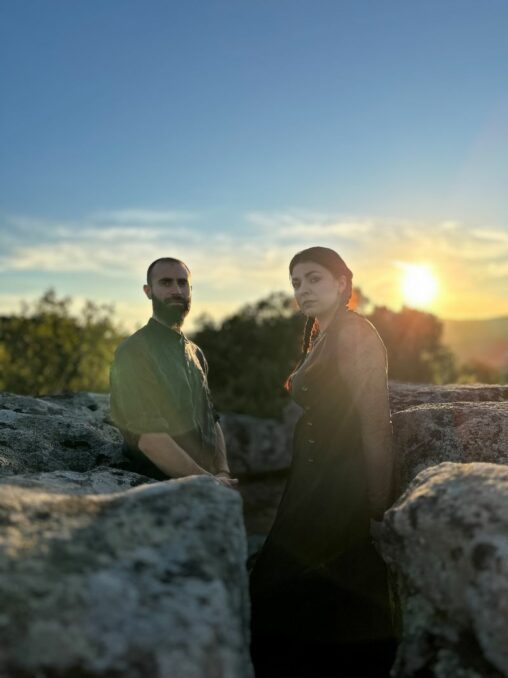
Ilienses: “We do everything in-house…”
I wanted to ask you—considering all the research that went into “Jae”, both in terms of studio preparation and the cultural exploration tied to the region—at some point, the actual music production must have begun as well. When did you start composing for the album?
That’s right—we do everything in-house. We have our recording studio, and both our first and second albums are self-produced in terms of composition, recording, mixing, and mastering. All of that work is done by us—primarily by Mauro, who handles the mixing and mastering as well. For the second album, though, we did receive additional support on the promotional and management side from Masked Dead Records. They believed in our project, and thanks to their backing, “Jae“ was released not as a fully independent production, but in collaboration with their label, based in the province of Brescia.
The artisanal instruments of Gavoi
You mentioned the traditional instruments of Gavoi, which I’d love to hear more about. But I also know that you create some of your instruments—ones that are not only featured on the album but also played live. Can you tell me more about that?
That’s right—the traditional instruments I mentioned earlier, especially the tumbarinu, which is Gavoi’s main instrument used throughout Carnival, are all handcrafted by Mauro. This is not just craftsmanship, but a form of art passed down through generations. Mauro learned this from his father, which led him to start making his drums.
In addition to the tumbarinu, we also have the tumborro, a very special instrument resembling a bow, which is played while connected to a pig’s bladder. It’s similar to the Brazilian berimbau, but with a Sardinian twist, and the sound it produces is deep, rough, and low—a key element of our music, especially in Mauro’s pieces.
Then we have the pipiolos, reed pipes, the sardinian flutes, and the benas, smaller versions of the launeddas. These are all crafted by local artisans. Similarly, the cowbells—which are iconic in my village of Tonara, known as the “village of cowbells”—are also handmade by local artisans. I’d like to say that this tradition is a unique example in Italy, not just Sardinia, of crafting bells by hand, a skill passed down from one generation to the next.
Raimundo Piras featured in Ilienses
Yes, absolutely. They truly are remarkable—it’s hard to find the right words to express how special they are. That’s why I also talk about the quest for sound, as well as the cultural journey in “Jae”‘s lyrics. I know that the title track draws its name from a composition by Raimundo Piras. What role did he play in your work? How did this poet influence you?
Well, then, the extemporary poets of Sardinia, so the poets, as we say in Bolu, improvised poetry poets, are de gurus for us. We rely on them both because they tell us things that have been handed down, precisely, through written poems, fortunately. After all, we are talking about poets of the twentieth century. Then some texts also come from further afield, for example, Pepino Mereu, who is a poet from Tonara, who was born in the late 19th century.
“The extemporary poets of Sardinia”
In the case, precisely, of “Jae”, he inspired us because, apart from his skill in narrating the poetry of this character, but also the theme that we felt was very topical, because this poem, in essence, investigates the nature of man and above all raises a question, a critique concerning how much man has in history wanted to dominate anything, nature for example, but also to go and know the sky, the stars, down to the abyss.
That’s it, that’s what he says, man has a claim to know even what’s beyond death, and so he raises a critique that in us stimulated an imagery that we then wanted to recreate through the single, but also through the writing of the whole record, because all the other tracks deal a little bit with these issues, they are connected, they talk about struggles, they talk about spirituality.
Of course, when we imagine our music, we find ourselves within our archaeological sites, within schedules.
“We struggle to understand…”
I’m always struck—every time I return to Sardinia—by the incredible variety within such a vast region: the richness of its culture, music, and archaeology. And I often wonder—if all of that heritage were better valued and utilized, couldn’t it also bring greater economic benefit?
Sure, it’s an island, and yes, it takes a ferry or an overnight trip to get there. But arriving in Olbia feels like stepping into another world. It makes sense now, after all these years, why my father used to say “the continent” to refer to mainland Italy. I understand it deeply now—because Sardinia and the continent are two worlds apart. They belong to the same country, yet they are both near and distant, especially in terms of cultural identity.
It’s true—very true—and it’s something we often discuss within the cultural community in Sardinia. Even we struggle to understand why such an extraordinary island, with its stunning landscapes and rich cultural heritage, still faces so many challenges in presenting itself to the world as it deserves.
“…the variety is incredible”
From the sea to the inland areas, the variety is incredible. And yet, there’s a real limitation in how the island is promoted. Too often, we fall back on a superficial kind of folklore—something more showy than meaningful—rather than embracing and sharing the deeper cultural richness Sardinia truly offers.
Exactly—because in the end, it doesn’t truly reflect what Sardinia is. It presents something familiar, but only on the surface—something everyone thinks they know, but few understand deeply.
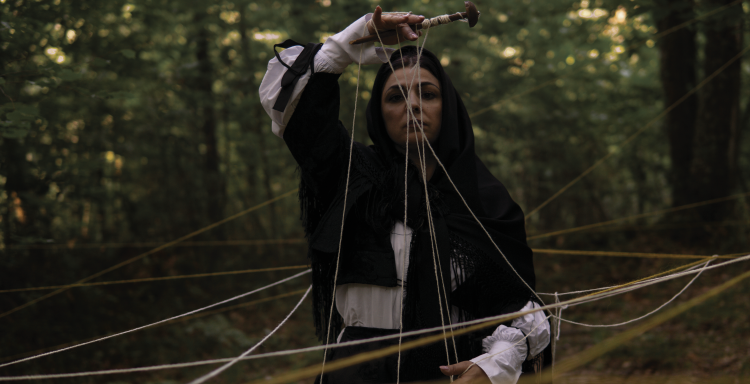
It’s easy to say, “Let’s bring in a folk group from Cagliari,” but Cagliari and Tonara, or Ossi in the province of Sassari, or even Bosa and Alghero, are completely different worlds. Just think—Alghero still speaks Catalan.
It’s frustrating that people often don’t grasp these differences. They only see the outer layer, the superficial image, without understanding the depth and diversity that define the island.
Exactly—even we Sardinians often struggle to truly understand our own culture. There’s a widespread lack of deep knowledge; we tend to stay on the surface, and not everyone takes the time—or has the tools—to dig deeper. That said, I don’t believe things are unchangeable. To be honest, over the past 10–15 years, there’s been a kind of awakening. Thanks in part to new archaeological discoveries, there’s a growing awareness of the island’s richness and potential. Something is shifting—it’s not like it used to be. Still, we too often fall back into the same clichés you just mentioned.
Presenting Ilienses to an international audience
Let me ask you something—I’m sure you’d love to take your music abroad, right, Natasha? But how do you manage to present something so layered and culturally rich to an international audience?
Even just translating all these nuances into English already risks losing so much meaning. It’s that classic “lost in translation” problem. And then there’s the added challenge of explaining the cultural differences between, say, a barbaricino and a campidanese. They might seem like small details, but they matter—a lot.
Most tourists only know northern Sardinia—Arzachena and that area. When you tell them to visit places like Gavoi or Mamoiada, they’re like, where even is that? Sorry for the language, but that’s really how it is. You get what I mean, right?
Absolutely—and I think it has to be a step-by-step process. You can’t expect people to understand everything all at once. The first and most important message, especially for foreign audiences, has to be the music itself. And honestly, that’s already been happening. We’ve had listeners from abroad who discovered us by chance on platforms like Spotify or Bandcamp. Even though they didn’t understand Sardinian or know anything about Sardinia, something in the music spoke to them—something that resonated with their history, their roots, something ancestral and universal that connects cultures and peoples across the world.
That’s the first connection we should aim for. Then, once they discover the sound, they’ll naturally become curious about what’s behind it all. That’s when we can start sharing the deeper cultural layers—hopefully with a bit of luck too, because in this kind of journey, luck definitely plays a part.
“…final 70-40 that makes the difference”
It also takes a bit of luck—because in the end, between strategy and serendipity, it’s often that final 70-40 that makes the difference.
Exactly. We hope there are people abroad—like you—who are genuinely curious about our music, and who might want to interview us or write a review of the album. That kind of interest is so valuable because from there, little by little, we can start reaching more people and opening doors to a wider audience.
The canto a tenore
By the way, something else I love is canto a tenore—the traditional tenores style of singing. I wanted to ask: what role does this particular mode, or style, of singing play within Ilienses?
Within Ilienses, canto a tenore plays several roles. We were especially fortunate that Mauro grew up singing tenore—he absorbed those sounds from childhood, so they’re deeply ingrained in him. Traditionally, as we know, this style of singing has always been performed by men in Sardinia.
What really defines the different tenores groups—especially the more well-known ones—is their moda. It’s not “fashion” in the Italian sense, but rather their distinctive style or vocal imprint, which is unique to each village. That’s what sets one group apart from another: their sound reflects the character of their specific community.
In this way, the voices themselves become musical instruments, rich with nuance and texture. And what’s incredible is how these variations can change from village to village—even just a few kilometers apart. Sadly, in many places, this tradition has been lost.
The role of canto a tenore in Ilienses
I know the tenores of Bitti, the tenores of Neoneli… Another one was coming to mind, but it’s slipping away right now…
The tenores of Bitti, the tenores of Neoneli—they’re among the most well-known because they’ve never lost this tradition. In fact, in some areas, there are so many tenores groups within the same small village. Imagine a village with only 3-4 thousand people yet hosting a dozen different tenore groups. That’s how alive and strong the tradition still is.
In Ilienses, we incorporated canto a tenore with this in mind. We like to think that, in ancient times, tenore singing may have also served as a way to connect with the divine. Much like early humans used drums in rituals to reach the gods, we imagine that tenore singing might have been another means for people to communicate with higher powers—perhaps even in sacred sites like our archaeological pits. So, for us, the tenore holds a deeply spiritual connotation, connecting the past with the present in a way that transcends just music.
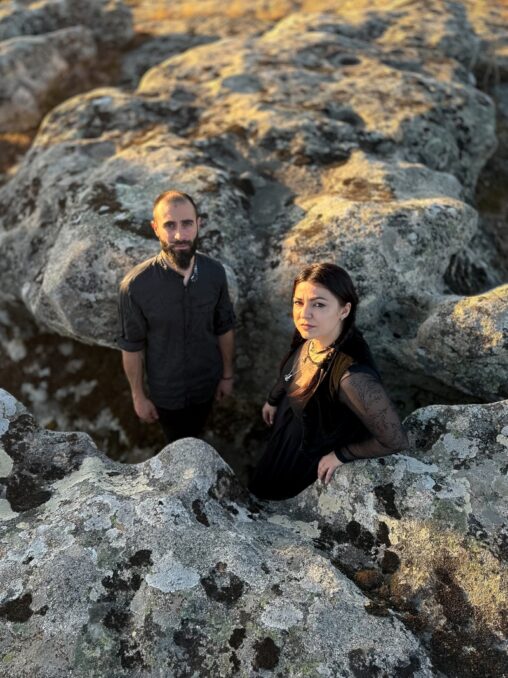
The video of “Ili Iur In Nurac Sessar”
I know you also shot the video for “Ili Iur In Nurac Sessar”. Can you tell me where it was filmed and a bit about the story behind it?
We actually shot several videos, and “Ili Iur In Nurac Sessar” is one that we created ourselves, with Mauro directing it. The video was filmed in the countryside near Gavoi, close to an archaeological site.
The inspiration for this track comes from an inscription whose meaning is still debated by historians. The inscription was found within a nuraghe—which has since collapsed—specifically the Uraghe Aiuduentos of Portigali. According to some historians, this inscription marks the first appearance of the word nurak, the term from which the word nuraghe originated. The inscription itself is a mix of Latin and Nuragic language, which adds an interesting layer to the history.
We were drawn to this discovery because it ties in with the historical research we’re passionate about. As I mentioned earlier, we don’t invent stories; we draw from the history we have and try to amplify it through our music. In the case of this track, we’re imagining struggles—those fought by ancient tribes, for instance.
The name Ilienses itself is inspired by tribes that once lived in the interior of Sardinia. These were often described as barbarian, resilient tribes who resisted the Roman invaders when they arrived in Sardinia. We take inspiration from these tales of resistance, of fierce attachment to their culture and land, and especially their fight to protect the values they held dear—values that, to us, are just as important today.
The cover artwork of “Jae”
I’m referring to the cover artwork, where you can see you holding a thread of wool. What is the significance of that thread?
The cover of “Jae“ was inspired by the figure of the Sa Filonzana, a mask from the village of Ottana. It’s one of the most unique and distinctive masks in Sardinia. What sets it apart is that it’s a female mask, unlike other more commonly known Sardinian masks such as the mamutones from Mamoiada, or the boes and merdules from Ottana. These masks are typically male, making the Sa Filonzana stand out even more in its symbolism and cultural significance. I’ll mention some of the most important masks…
The Sardinian masks
I’m familiar with the mammutones, as well as the boes and merdules, but Sa Filonzana is the first time I’ve heard of it too. It’s fascinating! I wasn’t aware of that one either.
Sa Filonzana is truly unique because she embodies a figure similar to the Greek moirai and parche—the sinister, almost terrifying female figures who controlled the thread of human lives. Sa Filonzana represents this very concept: the thread of wool in her hands symbolizes the thread of life. Typically, she’s depicted with scissors attached to her lap, symbolizing her power to cut the woolen thread—and with it, the life of a person. She’s the one who decides whether to preserve the thread, and thus a person’s life, or sever it.
She’s a deeply symbolic figure, representing themes of life, death, and fate—making her the perfect embodiment of these concepts in our work. Her presence inspired so many imaginative stories, and we wanted to represent her in our music and visuals.
The shirt I wear in the artwork is a reimagined version of the traditional dress from my village, Tonara, specifically the widow’s attire. Sa Filonzana also wears a widow’s outfit, but hers is from Ottana. While both are similar, I chose to wear the version from my village, as every village has its own distinct variations, with unique details that set them apart.
“Every village…”
I knew that! Every village has its own variations—while the general style of the dress is similar, with the eyes and the cross, it’s in the small details where the true uniqueness lies. Those details tell the story of each village, reflecting its history and traditions.
That’s right, the embroidery. The embroidery, the shoes, maybe the color of a shirt, the color of a dress. These are all details that belong to a country, you don’t find them…. Let’s say live, the performance makes it better, the drum is the main instrument. Live it’s really evocative, so we don’t exclude that we can add other elements over time as well.

Future live plans for Ilienses
I know you had a show scheduled at Cueva Rock in Cagliari at the end of the year. How is that coming together? What do you have planned for that performance? Have you managed to find a booking agent to assist with future dates?
I know that the Sardinian metal scene is quite active and present, but we always come back to the same issue. The lack of infrastructure limits the opportunities. Once you leave Cueva Rock and a few other venues in Sardinia, it becomes tough. The limited number of venues makes it difficult to maintain a regular presence and reach new audiences.
Exactly, we don’t plan to limit ourselves to Sardinia. While we can’t reveal the name of the person who will be accompanying us just yet, as you mentioned earlier about booking, we do have someone interested in helping us secure concert dates outside of the island. As you rightly pointed out, if we stay confined to Sardinia, there are very few thematic events that focus on this kind of music. Even though we played a lot last summer, the opportunities here are limited.
“Our goal for this year…”
Our music is perfect for representing places like archaeological sites, forests, and natural parks—those are our ideal stages. But, of course, we also want to bring our music beyond the island. This is where having a booking manager to help us with dates outside Sardinia would be incredibly useful. Fortunately, we already have someone who is actively working on finding us opportunities outside the island.
Our goal for this year is to not limit ourselves to Sardinia but to spread the word about Ilienses across Italy and especially abroad. Honestly, we believe that our audience is out there, abroad. We’ve noticed that foreigners tend to have a more refined ear and seem to connect better with the kind of musical dynamics we explore. They seem to understand our music in a way that’s been very encouraging for us.
Ilienses VS Heilung VS Wardruna
Some people have referred to you as the Sardinian version of Heilung or Warduna, and while I wouldn’t necessarily label it as right or wrong, I do think there’s some truth to those comparisons. It’s not about having a fixed definition, which could be limiting, but more about the right kind of assumptions, the right connections, if you will. I don’t find that wrong at all.
That’s true, and I don’t find it wrong either. It makes sense that we’re associated with bands like Heilung and Varduna, even though they tell different stories and draw from northern European sounds, which are naturally distinct from ours. But we all belong to the same musical branch, often referred to as neofolk or dark folk.
The common thread is that, like them, we draw inspiration from traditional sounds. Varduna, in particular, does this in a very profound way. Their leader, Heiner Selvig, is also a cultural researcher, and we really connect with his approach. He has delved deeply into the history of Northern Europe, particularly Norway, and brought those influences into his music, which resonates with us as well.
So, while we understand the comparison and agree with the association, we also want to make it clear that we don’t want to be too closely identified with northern European bands. Our roots, while connected in spirit, are deeply tied to Sardinia and its unique traditions.
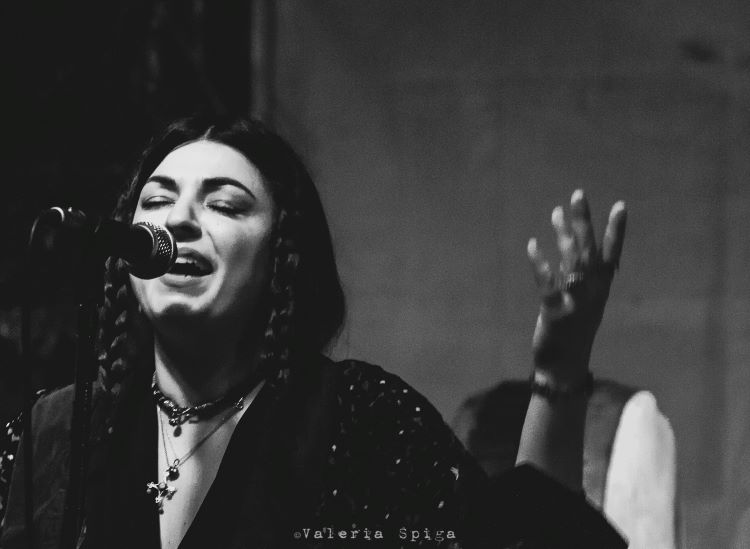
“We place a lot of importance on our origins”
I don’t want to limit ourselves to a simple comparison, because once you label something, it can be restrictive. It’s important to go beyond the label and truly explore. I’ve seen Varduna live three times and Heilung once. While they’re often compared, they’re very different. Heilung is much more of a theatrical experience, while Varduna is more static. It’s not fair to directly compare them. The same goes for us—we all have our own origins, and that should be recognized and respected.
Exactly, we place a lot of importance on our origins—they are our guide, our star. We trust that our listeners will understand this connection without needing too much explanation. Unfortunately, as you know, music often gets compartmentalized. When a band emerges, people want to categorize it, give it a name, and place it within a specific genre or world. But, while we acknowledge that we fit into a certain genre, we want to make it clear that our sound is distinctly Mediterranean, not Northern European. That’s an important distinction for us to emphasize.
Natascia, I thank you very much for the interview.
I hope you enjoyed it and I didn’t talk too much.It was very inspiring, really. I thank you for the questions you asked. Thank you very much.
